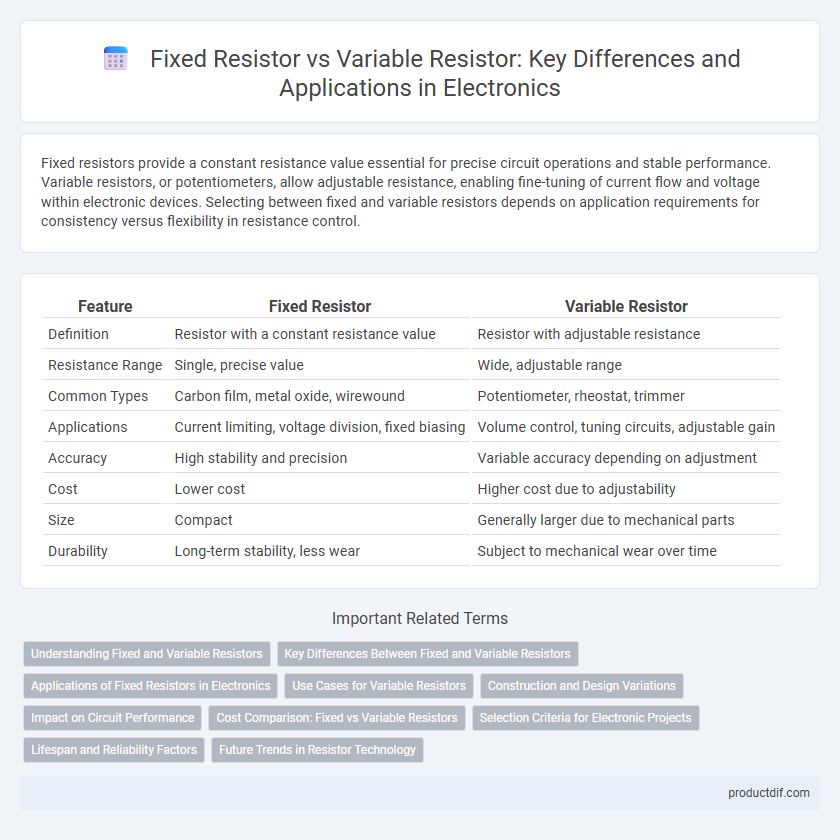Fixed resistors provide a constant resistance value essential for precise circuit operations and stable performance. Variable resistors, or potentiometers, allow adjustable resistance, enabling fine-tuning of current flow and voltage within electronic devices. Selecting between fixed and variable resistors depends on application requirements for consistency versus flexibility in resistance control.
Table of Comparison
| Feature | Fixed Resistor | Variable Resistor |
|---|---|---|
| Definition | Resistor with a constant resistance value | Resistor with adjustable resistance |
| Resistance Range | Single, precise value | Wide, adjustable range |
| Common Types | Carbon film, metal oxide, wirewound | Potentiometer, rheostat, trimmer |
| Applications | Current limiting, voltage division, fixed biasing | Volume control, tuning circuits, adjustable gain |
| Accuracy | High stability and precision | Variable accuracy depending on adjustment |
| Cost | Lower cost | Higher cost due to adjustability |
| Size | Compact | Generally larger due to mechanical parts |
| Durability | Long-term stability, less wear | Subject to mechanical wear over time |
Understanding Fixed and Variable Resistors
Fixed resistors provide a constant resistance value crucial for controlling current flow and voltage in electronic circuits, ensuring stability and precision in device performance. Variable resistors, such as potentiometers and rheostats, allow adjustable resistance to fine-tune circuit parameters and calibrate electronic components dynamically. Understanding the electrical characteristics and application-specific roles of fixed and variable resistors is essential for effective circuit design and optimization.
Key Differences Between Fixed and Variable Resistors
Fixed resistors provide a constant resistance value crucial for stable circuit performance, typically ranging from a fraction of an ohm to several megaohms. Variable resistors, such as potentiometers and rheostats, allow adjustable resistance, enabling precise control over voltage and current in applications like volume controls and tuning circuits. Unlike fixed resistors, which are designed for consistent operation, variable resistors facilitate dynamic circuit adjustments and calibration.
Applications of Fixed Resistors in Electronics
Fixed resistors are widely used in electronic circuits for setting precise voltage levels, limiting current flow, and dividing voltages in devices like power supplies, amplifiers, and signal processing units. Their stable resistance values make them ideal for applications requiring consistent performance, such as in biasing transistors, protection circuits, and timing components. Common applications include use in LED circuits, voltage regulation, and filter networks where fixed resistance ensures predictable and reliable operation.
Use Cases for Variable Resistors
Variable resistors, commonly known as potentiometers or rheostats, are extensively used for adjusting signal levels, tuning circuits, and controlling electrical devices such as volume controls in audio equipment. They enable precise manipulation of voltage and current in applications like sensor calibration, light dimming, and motor speed regulation. Variable resistors provide flexibility in circuit design, allowing for real-time adjustments without the need to replace components.
Construction and Design Variations
Fixed resistors feature a simple construction with a resistive element made from carbon film, metal film, or wire wound around a ceramic core, providing a constant resistance value. Variable resistors, such as potentiometers and rheostats, incorporate adjustable wipers that slide across a resistive track, enabling user-controlled resistance changes. Design variations in fixed resistors include axial and surface-mount types, while variable resistors differ in shaft size, taper (linear or logarithmic), and mounting style to suit diverse electronic applications.
Impact on Circuit Performance
Fixed resistors provide stable and precise resistance values essential for maintaining consistent current flow and voltage levels in electronic circuits, ensuring predictable and reliable performance. Variable resistors, such as potentiometers or rheostats, allow adjustable resistance, enabling fine-tuning of circuit parameters like signal amplitude, biasing, and voltage division for dynamic control and calibration. The choice between fixed and variable resistors directly affects circuit flexibility, accuracy, and stability based on application requirements.
Cost Comparison: Fixed vs Variable Resistors
Fixed resistors generally cost less than variable resistors due to their simpler design and manufacturing process. Variable resistors, such as potentiometers and rheostats, require more complex construction to allow adjustment, leading to higher production expenses and retail prices. For budget-sensitive applications, fixed resistors provide a cost-effective solution, whereas variable resistors are preferred when circuit tuning or calibration is necessary despite the increased cost.
Selection Criteria for Electronic Projects
Fixed resistors offer precise resistance values essential for projects requiring stable voltage and current control, ensuring circuit reliability. Variable resistors provide adjustable resistance, ideal for tuning and calibration tasks where flexibility in signal levels or biasing is necessary. Selection criteria depend on the need for fixed resistance precision versus adaptability in resistance, power rating, tolerance, and physical size constraints in the electronic design.
Lifespan and Reliability Factors
Fixed resistors generally have a longer lifespan and higher reliability due to their simpler construction and fewer moving parts, reducing the risk of mechanical failure. Variable resistors, such as potentiometers and rheostats, face increased wear and tear from frequent adjustments, which can degrade contact surfaces and lead to inconsistent resistance over time. Environmental factors like temperature and humidity affect both types, but fixed resistors typically withstand harsh conditions better, contributing to their durability in critical electronic circuits.
Future Trends in Resistor Technology
Emerging trends in resistor technology highlight advancements in nano-materials and precision manufacturing processes aimed at enhancing reliability and miniaturization of fixed and variable resistors. Integration of smart resistors with IoT capabilities allows real-time resistance adjustments and predictive maintenance in electronic circuits. Developments in thin-film and graphene-based resistors are set to revolutionize power efficiency and thermal stability in next-generation electronic devices.
Fixed resistor vs Variable resistor Infographic

 productdif.com
productdif.com